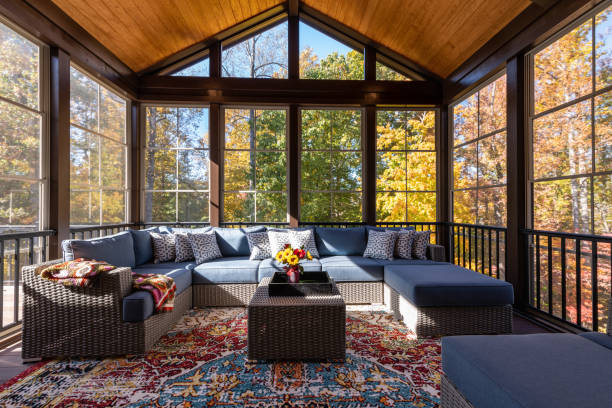Solarium vs. Sunroom: Differences, Prices, and More
When considering a home addition that enhances your living space with natural light, both solariums and sunrooms offer appealing options. While these terms are often used interchangeably, they refer to different types of structures with distinct features, purposes, and costs. Understanding the differences between a solarium and a sunroom can help you make an informed decision about which is right for your home.
What Is a Solarium?
Overview: A solarium is a glass-enclosed space designed to maximize natural light and provide a panoramic view of the outdoors. It is often used as a year-round living area or a garden space.
Features:
- Glass Walls and Roof: Typically features floor-to-ceiling glass walls and a glass roof, allowing for abundant natural light and unobstructed views.
- Climate Control: May include heating and cooling systems to maintain a comfortable temperature year-round.
- Uses: Commonly used as a greenhouse, sitting area, or a space for growing plants.
Benefits:
- Maximized Natural Light: Offers extensive exposure to natural light, creating a bright and airy environment.
- Scenic Views: Provides unobstructed views of the surrounding landscape.
Considerations:
- Cost: Generally more expensive due to the extensive use of glass and structural requirements.
- Temperature Regulation: Can become overheated in summer and chilly in winter without proper climate control.
What Is a Sunroom?
Overview: A sunroom, also known as a conservatory or Florida room, is a versatile addition designed to offer a space that blends indoor comfort with outdoor views. It typically features large windows but may not have a glass roof.
Features:
- Window Walls: Usually includes large windows and may have some sections of solid walls.
- Roof Options: Can have a traditional roof or a partially glass roof, depending on design preferences.
- Uses: Often used as a casual living area, dining space, or additional entertainment area.
Benefits:
- Versatile Use: Can be designed to serve multiple purposes, such as a family room or dining area.
- Cost-Effective: Generally less expensive than solariums due to less extensive glass usage.
Considerations:
- Less Natural Light: May not provide as much natural light as a solarium, especially if it has a traditional roof.
- Temperature Control: Easier to regulate temperature with standard roofing and wall insulation.
Differences Between Solarium and Sunroom
1. Structure and Design:
- Solarium: Features extensive glass walls and roof, offering panoramic views and maximum natural light.
- Sunroom: Includes large windows and may have a traditional roof, providing a more traditional room feel with less glass.
2. Purpose:
- Solarium: Often used as a greenhouse or for growing plants, emphasizing natural light and views.
- Sunroom: Typically designed as an additional living space or recreational area, blending indoor and outdoor elements.
3. Cost:
- Solarium: Usually more expensive due to the high amount of glass and structural complexity.
- Sunroom: Generally more budget-friendly, with costs varying based on window type and roof design.
4. Temperature Control:
- Solarium: Requires more advanced climate control systems to manage temperature fluctuations.
- Sunroom: Easier to control temperature with traditional roofing and insulation options.

Costs of Solarium vs. Sunroom
1. Solarium Costs:
- Basic Installation: $15,000 to $50,000 or more, depending on size, materials, and design complexity.
- Climate Control: Additional costs for heating and cooling systems.
2. Sunroom Costs:
- Basic Installation: $10,000 to $30,000, depending on size, window type, and roofing options.
- Additional Features: Costs can increase with added features like custom flooring or integrated furniture.
Choosing the Right Option for Your Home
When deciding between a solarium and a sunroom, consider the following factors:
- Budget: Solariums are typically more expensive, so assess your budget and financial flexibility.
- Functionality: Determine how you plan to use the space. A solarium is ideal for maximizing natural light and plant growth, while a sunroom offers versatility for various activities.
- Climate: Consider your local climate and how each option will perform in terms of temperature control and insulation.
Conclusion
Both solariums and sunrooms offer unique benefits and can enhance your home’s livability and aesthetic appeal. By understanding their differences, costs, and functionality, you can make an informed decision that best suits your needs and preferences. Whether you choose a solarium for its panoramic views and natural light or a sunroom for its versatility and cost-effectiveness, either addition can provide a beautiful and functional space for relaxation and enjoyment.
Check Out This Blog!

